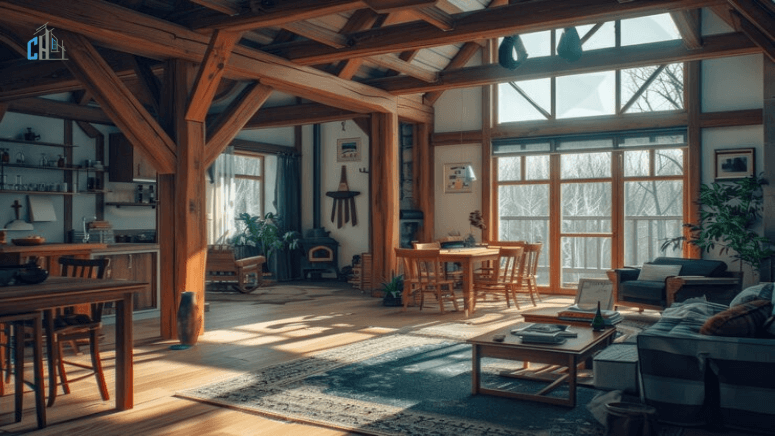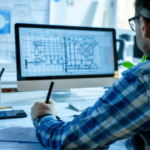Modern eco-friendly prefab homes are revolutionizing the housing industry by efficiently addressing climate concerns. These sustainable dwellings minimize environmental impacts through energy-efficient designs, the use of renewable materials, and reduced construction waste, paving the way for a greener future.
In recent years, the conversation around climate change has never been louder. With the growing concerns about our planet’s health, many homeowners are seeking sustainable living solutions. This shift has given rise to an innovative trend in the housing market—eco-friendly modular homes.
In this blog post, we’ll explore how these modern dwellings are addressing climatic concerns, offering a blend of sustainability and style.
What Are Eco-Friendly Prefab Homes?
Further, green, more specifically, eco-friendly prefab houses known as modular homes are constructed away from the site in factories. These modules are then taken to the site and they assemble the building. These homes are specifically constructed to be environment friendly and incorporate use of sustainable resources and green energy.
Comparatively they generate low impacts on the environment and utilize less resources in construction, thus becoming preference for green homeowners.
Mobile homes have evolved from their mere minimalistic structures originally. Today’s designs are more modern, stylish, and in some cases pre-programmed to meet a client’s specific needs.
There is a prefab home for you whether you are in the USA, Canada, UK, or Australia and in terms of looks, there is no compromise on this. However the unique point about these homes is that they aim at minimizing their impact on the environment.
Sustainable Benefits of Building Green Prefab Homes
Did you know? Consider this, construction sites contibute to about 40 percent of the overall wastage that ends up in the landfill. The table below shows that through implementation of green building practices to homebuilders produces a conclusive evidence that the amount of construction wastes could be cut down to 90% less than regular building construction.
Including the even stricter quality control and reviews with CAD drafters in the US, the firms that deal with green building, investors, and buyers who are interest in prefab eco-home, stand to benefit from the following aspects of sustainable architecture.
Less Carbon Emissions
Another benefit that cannot be overlooked when working on the aspects of green prefab homes is low impact on the environment.
The methods that have been use for constructing buildings in the past are generally slow and has considerable wastage, which increases the levels of emissions of carbon. On the same note, modular construction is relatively quicker and lot more efficient in the construction process.
As a matter of fact, it appears that prefab homes in the UK can cut carbon emissions by 50 percent than conventional homes. This is good for combating climate change since construction accounts for a significant part of greenhouse gas emissions.
Thus, it is crucial for homeowners to know that by opting for structural modular buildings, structural design of building their harms done to the environment will reduce dramatically.
Also, justifiably, the organised factory environment enhances on quality exercise, hence leading to minimal material wastage. Consequently, this implies that building structures will be able to visit the landfill less often and will incorporate more recycled materials in construction. The end product is quite a stunning home that is actually a lot less cruel to the earth than the conventional ones.
Excellent Energy Efficiency
Energy efficiency is another area where eco-friendly prefab homes excel. These homes are often built with state-of-the-art insulation and energy-saving technologies. This includes everything from double-glazed windows to solar panels, all designed to reduce energy consumption.
For instance, many prefab homes come equipped with energy-efficient HVAC systems and smart thermostats. These features help maintain a comfortable indoor temperature while using less energy. The result is lower utility bills and a smaller carbon footprint.
Furthermore, the use of CAD drafters in the US allows for precise architectural construction drawings services. This precision ensures that every aspect of the home is optimize for energy efficiency. From the placement of windows to the thickness of walls, every detail is carefully consider to maximize energy savings.
Repurposed Materials
Another principle when constructing green prefab homes is that the utilize materials must be reclaim and recycle. The same materials can help decrease the amount of waste and the demand for new raw materials, which usually have a negative impact on the environment.
For instance, used timber and scrap iron which are key components when developing environment friendly houses on sites, can use to create efficient modern homes for site construction.
This process of giving a second life to items and material does not only apply to the framework of the house. Builders also use recycled material during the interior decoration of the home to make their home eco-friendly.
This includes such materials as recycled glass for countertops, to fiber reclaimed for weaving carpets. The end product is a house that is fashionable and ecological.
When constructing their homes, homeowners should also consider the extent to which they can utilize recycled materials hence minimizing their use non-renewable sources.
This is consider to be one of the significant steps towards the development of better tomorrow and global warming issues. Furthermore, it is possible to reach a good result with the help of reused materials; in this way, the home will be unique.
Minimal Environmental Disruptions
Conventional construction of homes poses a great threat to fauna and flora that are suppose to preserve as per the global standards. This usually involves elimination of vegetation in big tracts of land, a process that negatively affects the habitat of various creatures and triggers soil erosion. Yet, eco-friendly prefab homes do not disrupt these as is the case with the traditional home construction methods.
Prefab structures are often construct in factories; therefore, there are minimal demands for clearing large expanses of land. This, in turn, promotes the conservation of local environment and the pressure on native flora and fauna is relatively smaller. Also, assembly on-site is slightly faster and has a weaker impact on the surroundings, which helps avoid detrimental effects on the environment.
This is also a beneficiary formula to the homeowners. Thus, an indeterminate project disrupts the construction process a lesser extent thus resulting to minimum interferences with the community. It guarantees that the construction process does not harm the environment and nearby buildings or units.
This is especially the case where several kinds of construction activity are taking place in a populated region and the density of constructions can hamper with the aspects of daily life.
Reduced Construction Delays
Another box on the negative side of conventional home construction is that there arises many issues of delays. In this process, factors such as weather conditions, inadequate workforce and problems in getting materials also affect the construction activity.
While conventional building construction is time-consuming, particularly when it comes to organizing and scheduling tasks, modular construction is relatively straight forward and much easier to schedule.
Due to the fact that green prefab homes are construct inside a factory, they do not experience confrontations with atmospheric conditions.
This means that at the end of every project, the work will be done to the deadline that has been set for the project. To the homeowners, this means that they will not stress and rather anxious especially when they are seeking for some home remodeling services.
Furthermore, the effectiveness of construction and design in the modularity of the system contribute the aspect of cost reduction. Less delays imply less expenses since they are always a result of a delay, therefore prefab home construction can be economical.
This is rather favourable for those owners who are interest in cutting down their impact on the environment but, at the same time, cannot afford to spend too much on materials.
Final Words on Eco-Prefab Home Designs & Construction Planning
Eco-friendly prefab homes are revolutionizing the way we think about sustainable living. They offer a range of benefits, from reduced carbon emissions and excellent energy efficiency to the use of repurposed materials and minimal environmental disruptions. By choosing modular construction, homeowners can enjoy a beautiful, functional home that aligns with their values.
Whether you’re in the USA, Canada, UK, or Australia, eco-friendly prefab homes are a viable option for anyone looking to live sustainably. They represent a forward-thinking approach to housing that addresses some of the most pressing climatic concerns of our time.
Are you ready to take the next step towards sustainable living? Learn more about how eco-friendly modular homes can benefit you and the planet. Explore architectural construction drawings, hire CAD drafters in the US, and interior and exterior 3D renderings to get started on your eco-friendly home journey today.




